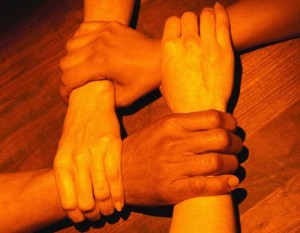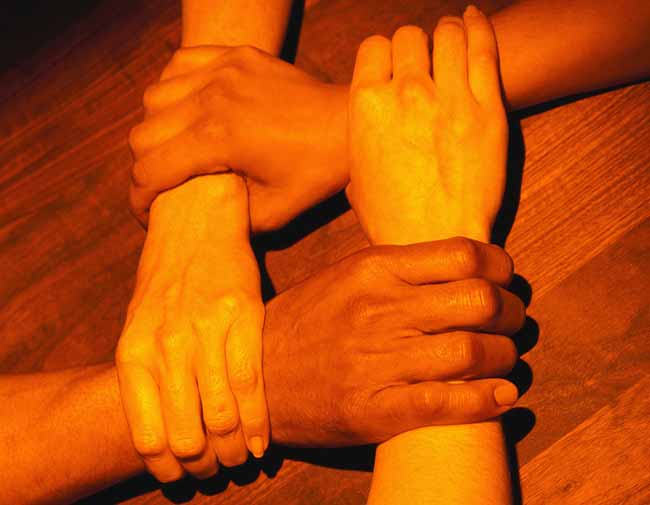You probably didn’t think it was possible. How could this be? It’s scandalous! Providing opioids for the very people who are trying so desperately to get off them. But since this is Week 2 of our be-nice-to-12-step extravaganza, let me tell you the story.
In the comments following my last post, Elizabeth told us of a study (Coan and colleagues, 2006) showing that hand-holding can diminish people’s response to threat. Unfortunately the link only takes you to a brief summary of the study. I went back and read the full version, and this is what happened.
Fifteen women who reported high quality marriages were put into an fMRI scanner, with their husbands and the experimenter remaining outside in the room. The women were shown cues on a screen several seconds before an electric shock was possibly administered to their ankle by an electrode. These electrical zaps are generally only slightly painful (in psychological experiments). But the cue on the screen, coming a few seconds earlier, is bound to make one anxious. Especially because it announces that a shock may come, but it may not. In other words, the subject is in a state of uncertainty and anxiety, waiting to see if the shock will come or not.
This experimentally-induced state of threat or anxiety is, of course, meant to simulate real-life stress. And I think that’s fair enough. Let’s get specific about opiate addicts. Will I be okay? Will I be able to restrain myself today? Or will things get so shitty that I’ll fall off the wagon — again? And if I do, there will be hell to pay when I get home…etc, etc, etc. We all know the drill. Being an opiate addict in recovery is being in a state of anxiety or stress — for much of the time — and the only relief may be…a shot of heroin (or pills, or whatever) OR a visit to your local NA group. That makes you feel better too. That’s why you go.
Little did we know that the group makes you feel better for the same reason (at the cellular level) as a shot of heroin.
Some very prominent emotion scientists have theorized that opioids (made inside our brains) are at the root of human attachment. Mother’s milk is rich with opioid molecules. In other words, nature found a surefire way to soothe the baby with its mother’s milk, using the same chemical formula that’s responsible for the soothing feeling of heroin. Jaak Panksepp theorizes that all social attachment is based on the release of opioids within the brain. Here’s a quote from him, referring to his early attempts to publish this work, cited in a very nice review for the non-scientist:
“When we first tried to publish our paper on the role of opioids in social attachment in three species, we submitted it to Science,” he said. When he asked the editor [why the paper was rejected, he was told], “‘We decided it was too hot to handle. If love and attachment ride on the same system as narcotic addiction, that’s too scary…’ ”
The review goes on to show how parents also get opioids from their kids. They feel great gobs of love and mush because their own brains produce a glut of opiods just at the sight of those sweet little faces. But let’s get back to Coan and colleagues’ experiment.
 When the woman in the scanner was holding her husband’s hand, through a little hole in the side of the machine, many brain regions involved in stress or negative emotion showed reduced activation. On some trials, the hand she held was not her husband’s but that of the experimenter, a friendly male stranger. Even on those trials, many of the same brain regions showed reduced activation. Now here’s the kicker: The brain regions that got calmed down by hand-holding (including regions of the ventral ACC, ventral prefrontal cortex, striatum, and insula) are the same brain regions that have a high density of opioid receptors! The authors speculate (and I think it’s very likely) that opioid release is what causes the deactivation of these emotional hot spots. The subjects also reported less unpleasantness when they were holding hands while anticipating the shock. And, get this, the reduction in unpleasantness was correlated with the reduction in brain activity in these hot spots.
When the woman in the scanner was holding her husband’s hand, through a little hole in the side of the machine, many brain regions involved in stress or negative emotion showed reduced activation. On some trials, the hand she held was not her husband’s but that of the experimenter, a friendly male stranger. Even on those trials, many of the same brain regions showed reduced activation. Now here’s the kicker: The brain regions that got calmed down by hand-holding (including regions of the ventral ACC, ventral prefrontal cortex, striatum, and insula) are the same brain regions that have a high density of opioid receptors! The authors speculate (and I think it’s very likely) that opioid release is what causes the deactivation of these emotional hot spots. The subjects also reported less unpleasantness when they were holding hands while anticipating the shock. And, get this, the reduction in unpleasantness was correlated with the reduction in brain activity in these hot spots.
Thanks for the opioids, dear.
Elizabeth said in her comment that she heard a lecture by the same researcher, reporting that some of the same neural calming effect was found when the person’s partner was just in the same room with them, never mind hand-holding. So you don’t need to hold someone’s hand to get opioid soothing. You just need someone who cares for you to be in the same room.
In a recent debate on this blog, I argued that a supportive group like NA makes sense as a primary treatment for addiction–not a secondary one. Certainly members of NA or AA see their group experience — with or without hand-holding — to be the most powerful antidote to their feelings of anxiety, stress, loneliness, and all the other negative variants that can lead to relapse. Now we can point to a very concrete, biological mechanism responsible for the soothing function of the group: when you are in close contact with people who care about you (even a little), your own brain releases opioids. And, in a sense, those opioids replace the opioids you’d otherwise be buying on the street.
A final word: this is not some cheap trick the brain is playing on you. Internal opioids are not like methadone maintenance. Opioids have been nature’s way of soothing our pain and our stress, for tens of millions of years of evolution! That’s why we need them. That’s why we like them. NA, and other forms of intimate group experience, help us to get them from our connections to other humans (something we’ve perhaps forgotten how to do) rather than the guy on the street corner.
That’s what nature intended.

Leave a Reply to Richard Henry Cancel reply